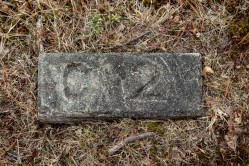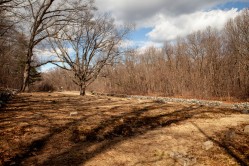
MetFern Cemetery
Location
42.399615, -71.2064History
In 1930, the expansive Metropolitan State Hospital (colloquially known as "Met State") was built on Trapelo Road, almost directly across from the Fernald Center. It was the last large-scale state hospital to be built in Massachusetts, and being in such close proximity to Fernald, the two institutions often shared resources. Fernald patients were shuttled to Met State's state-of-the-art operating room for major surgery, while food was grown on Fernald's expansive farm. The two hospitals also shared staff members and a cemetery for their patients.
Many people living in these institutions had no one outside the hospital to care for them, and oftentimes it was impossible to find a living relative to arrange for burial when they died. Most state hospitals thus maintained their own cemeteries and due to the negative stigma of having a mentally ill or disabled person in the family, the graves were marked only with a patient number.
In 1947, the Commonwealth established a cemetery near Met State's pathology lab, located at the foot of a steep ledge. The area was marshy, with a small depression that often turned into a pond during the spring season. It was colloquially known as "MetFern Cemetery," as patients from both institutions were buried here throughout the years. Two sections exist at the cemetery, categorized by the religion of the deceased (this was of course often presumed for very young or non-verbal patients who had no living relatives). The only two options were Catholic or Protestant. The caskets were simple pine boxes made at the wood shop and burials occurred with little ceremony. With its high water table, graves would occasionally become inundated with groundwater shortly after being dug; sometimes they weren't even pumped out before the body was laid to rest. A small concrete marker engraved with the patient's number served as a headstone.
In the early 1970s a groundskeeper named Wayne Brasco worked with Father Henry Marquardt, the Catholic chaplain at Fernald, to change this deplorable method of burial. Father Marquardt formed the Death and Dying Committee, an organization that worked with staff, patients, and families to provide dignified end-of-life care and funeral services for patients. Mr. Brasco helped find ways to seek other burial sites and curtail using the MetFern Cemetery altogether.
As a stronger advocacy for patient's rights began to develop, it was possible to use social security money to help pay for end-of-life care and funeral expenses. Families soon had the option of installing a proper headstone instead of a numbered concrete marker. When the patients of both institutions were re-classified as actual residents of the city of Waltham, Brasco and Marquardt spoke with mayor Arthur Clark and convinced him that they should then have the right to be buried in the town's Mt. Feake Cemetery. Although it was a slow progression, with both Brasco and Marquardt personally helping to pay for the interments at Mt. Feake, their efforts were successful. MetFern's last official burial took place in 1979, except for a single instance in 1986 when two preserved human heads were discovered in Fernald's pathology lab and buried in the cemetery.
Father Marquardt collapsed and died while working at the Fernald Center in 1992; the Thom Hospital was re-named in his honor as the Marquardt Nursing Center. Met State was subsequently closed that year after a slow decline. MetFern also became overgrown and largely forgotten. The Commonwealth had no plan for long-term maintenance of the plots, so upkeep is performed by volunteers. The cemetery is only accessible via footpath through the former Met State grounds.
It is unclear where Fernald patients were buried prior to 1947, though it is likely they were interred in or near Mt. Feake Cemetery in Waltham. Funeral expenses do not appear in Fernald's Annual Reports until the year 1902.







